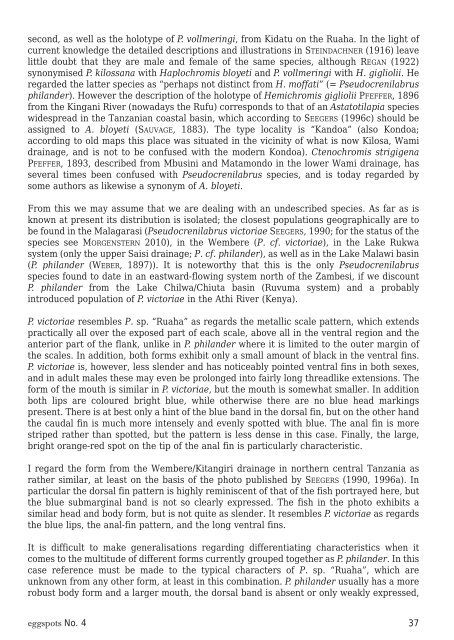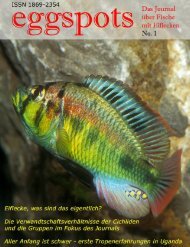Eggspots Elsewhere - Welt der Fische / World of Fishes
Eggspots Elsewhere - Welt der Fische / World of Fishes
Eggspots Elsewhere - Welt der Fische / World of Fishes
You also want an ePaper? Increase the reach of your titles
YUMPU automatically turns print PDFs into web optimized ePapers that Google loves.
second, as well as the holotype <strong>of</strong> P. vollmeringi, from Kidatu on the Ruaha. In the light <strong>of</strong><br />
current knowledge the detailed descriptions and illustrations in STEINDACHNER (1916) leave<br />
little doubt that they are male and female <strong>of</strong> the same species, although REGAN (1922)<br />
synonymised P. kilossana with Haplochromis bloyeti and P. vollmeringi with H. gigliolii. He<br />
regarded the latter species as “perhaps not distinct from H. m<strong>of</strong>fati” (= Pseudocrenilabrus<br />
philan<strong>der</strong>). However the description <strong>of</strong> the holotype <strong>of</strong> Hemichromis gigliolii PFEFFER, 1896<br />
from the Kingani River (nowadays the Rufu) corresponds to that <strong>of</strong> an Astatotilapia species<br />
widespread in the Tanzanian coastal basin, which according to SEEGERS (1996c) should be<br />
assigned to A. bloyeti (SAUVAGE, 1883). The type locality is “Kandoa” (also Kondoa;<br />
according to old maps this place was situated in the vicinity <strong>of</strong> what is now Kilosa, Wami<br />
drainage, and is not to be confused with the mo<strong>der</strong>n Kondoa). Ctenochromis strigigena<br />
PFEFFER, 1893, described from Mbusini and Matamondo in the lower Wami drainage, has<br />
several times been confused with Pseudocrenilabrus species, and is today regarded by<br />
some authors as likewise a synonym <strong>of</strong> A. bloyeti.<br />
From this we may assume that we are dealing with an undescribed species. As far as is<br />
known at present its distribution is isolated; the closest populations geographically are to<br />
be found in the Malagarasi (Pseudocrenilabrus victoriae SEEGERS, 1990; for the status <strong>of</strong> the<br />
species see MORGENSTERN 2010), in the Wembere (P. cf. victoriae), in the Lake Rukwa<br />
system (only the upper Saisi drainage; P. cf. philan<strong>der</strong>), as well as in the Lake Malawi basin<br />
(P. philan<strong>der</strong> (WEBER, 1897)). It is noteworthy that this is the only Pseudocrenilabrus<br />
species found to date in an eastward-flowing system north <strong>of</strong> the Zambesi, if we discount<br />
P. philan<strong>der</strong> from the Lake Chilwa/Chiuta basin (Ruvuma system) and a probably<br />
introduced population <strong>of</strong> P. victoriae in the Athi River (Kenya).<br />
P. victoriae resembles P. sp. “Ruaha” as regards the metallic scale pattern, which extends<br />
practically all over the exposed part <strong>of</strong> each scale, above all in the ventral region and the<br />
anterior part <strong>of</strong> the flank, unlike in P. philan<strong>der</strong> where it is limited to the outer margin <strong>of</strong><br />
the scales. In addition, both forms exhibit only a small amount <strong>of</strong> black in the ventral fins.<br />
P. victoriae is, however, less slen<strong>der</strong> and has noticeably pointed ventral fins in both sexes,<br />
and in adult males these may even be prolonged into fairly long threadlike extensions. The<br />
form <strong>of</strong> the mouth is similar in P. victoriae, but the mouth is somewhat smaller. In addition<br />
both lips are coloured bright blue, while otherwise there are no blue head markings<br />
present. There is at best only a hint <strong>of</strong> the blue band in the dorsal fin, but on the other hand<br />
the caudal fin is much more intensely and evenly spotted with blue. The anal fin is more<br />
striped rather than spotted, but the pattern is less dense in this case. Finally, the large,<br />
bright orange-red spot on the tip <strong>of</strong> the anal fin is particularly characteristic.<br />
I regard the form from the Wembere/Kitangiri drainage in northern central Tanzania as<br />
rather similar, at least on the basis <strong>of</strong> the photo published by SEEGERS (1990, 1996a). In<br />
particular the dorsal fin pattern is highly reminiscent <strong>of</strong> that <strong>of</strong> the fish portrayed here, but<br />
the blue submarginal band is not so clearly expressed. The fish in the photo exhibits a<br />
similar head and body form, but is not quite as slen<strong>der</strong>. It resembles P. victoriae as regards<br />
the blue lips, the anal-fin pattern, and the long ventral fins.<br />
It is difficult to make generalisations regarding differentiating characteristics when it<br />
comes to the multitude <strong>of</strong> different forms currently grouped together as P. philan<strong>der</strong>. In this<br />
case reference must be made to the typical characters <strong>of</strong> P. sp. “Ruaha”, which are<br />
unknown from any other form, at least in this combination. P. philan<strong>der</strong> usually has a more<br />
robust body form and a larger mouth, the dorsal band is absent or only weakly expressed,<br />
eggspots No. 4<br />
37




